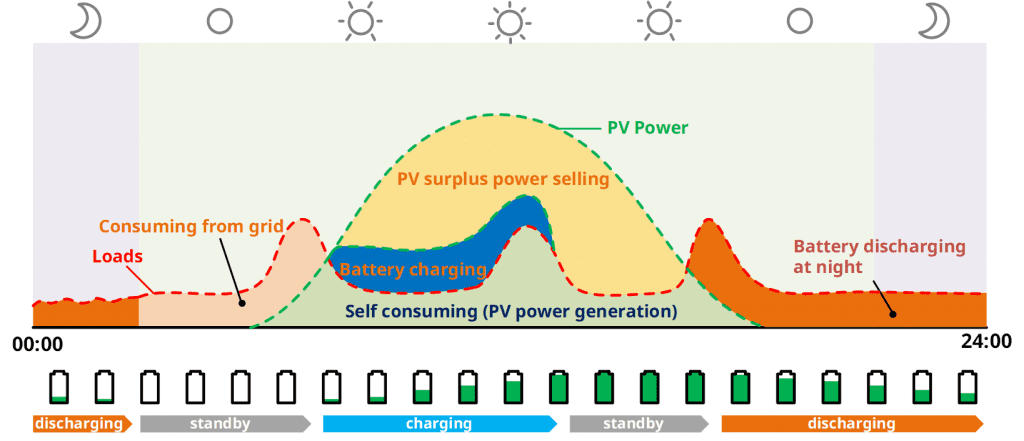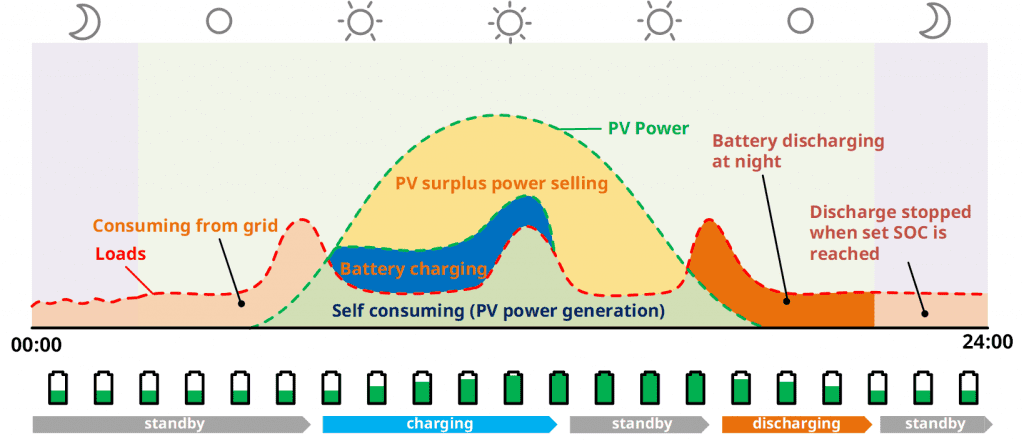How Hoymiles hybrid inverters give you complete control: Explore our three operation modes
Key takeaways
- Hoymiles hybrid inverters offer three operation modes: Self-Consumption Mode, Economical Mode (TOU), and Backup Mode.
- Self-Consumption Mode prioritizes getting you the energy your home needs while minimizing the amount of power drained from the grid.
- In Economical Mode (TOU), you can set different energy-use patterns for different time frames to create the most economical plan for your system.
- Backup Mode is recommended in areas with frequent grid outages.
Table of Contents
In a world of volatile fuel prices, rising electricity bills, and grid instability caused by extreme weather, more and more people are switching to solar. And, in the process, working to gain their energy independence.
Hoymiles hybrid inverters are designed to put power back in people’s hands by giving them access to a reliable source of backup power – so they can make smarter, safer solar energy use a reality.
While most inverters only convert DC solar power into AC power that is consumed by house appliances, hybrid inverters can also convert AC power to DC power. This means that, with a hybrid inverter, you can integrate batteries into your solar system to provide power backup. Hybrid inverters can also connect with a diesel generator, forming a complete off-grid system in case the grid goes down.
A hybrid inverter system uses multiple energy sources. To achieve the best results, you’ll need to make wise decisions on how and when to mobilize each of these energy sources.
Hoymiles hybrid inverters offer three modes, so you can always make the best choice for your energy use. The three modes are: Self-Consumption Mode, Economical Mode (TOU), and Backup Mode.
Now let’s explore exactly how the system operates in each of these different modes, and when you should use each one.
Self-Consumption Mode
In this mode, the system will prioritize making sure you have enough energy to meet the needs of your home, rather than storing electricity in the battery or feeding power to the grid.
In the daytime, when your PV modules start to work and generate solar power, your system will first focus on meeting the demand of your home appliances. Then any surplus energy will be stored in the battery. When the battery is fully charged or reaches the maximum charge power, any excess energy can be “sold” to the grid. You can also set a power export limit, as required by your grid operator, to control exactly how much of your excess energy is fed back into the grid. The catch here is that not all places allow you to feed power to the grid, so you always need to check your local regulations.

After the sun sets, your battery – which was fully charged during the day – will begin discharging to support the energy needs of your home. When your battery starts running low, the grid will kick in to supply your demand. But note that in this mode, your battery cannot be charged from the grid at night – you will need to wait until your PV modules start working again the next day to recharge it.
The rule of thumb is that in Self-Consumption Mode, the system always tries to use solar power first, minimizing your reliance on grid power.

Economical Mode
If you want to save as much money as possible on your energy bills, this is the mode for you.
Economical Mode allows you to squeeze the most benefit from peak-valley electricity price schemes.
With Economical Mode, you can set peak hours, off-peak hours, and partial-peak hours based on your local electricity price to control when your battery charges and discharges. You can also set specific time periods for using grid or solar power based on the days and seasons to form your own power usage scheme.
In practice, this means that, if solar power is unavailable, you can switch to battery power during peak hours when electricity prices are high. You can also sell any surplus power to the grid to get more compensation.
During off-peak hours (mainly at night when PV stops working), your battery will then start to charge using lower-priced power from the grid. The caveat is that some countries, like the United States, forbid using grid power to charge batteries, so make sure you check local regulations.

As you can see from the diagram, your battery’s state of charge (SOC) fluctuates throughout the day; you’ll use battery power during peak hours and charge the battery during off-peak hours.
Let’s look at a real-life scenario to see how exactly this mode works. Let’s say peak hours are from 8 am to 9 pm, and off-peak hours are from 9 pm to 8 am.
PV | Battery | Grid | Energy costs | |
8 am – 10 am | PV starts to work | Discharging | Standby | Peak hours |
10 am – 5 pm | PV working | Charging from PV | Feed surplus power to grid | Peak hours |
5 pm – 9 pm | PV stops working | Discharging | Standby | Peak hours |
9 pm – 12 am | PV stops working | Charging | Draw from grid when battery runs low | Off-peak hours |
12 am – 8 am | PV stops working | Standby | / | Off-peak hours |
Here is a visual representation of how the system operates throughout the day in the Economical Mode.

Backup Mode
This mode is used in areas that experience frequent power outages. It works in a similar way to Self-Consumption Mode. The only difference is that you need to set a backup power SOC (state of charge) – a limit on how much your battery is allowed to discharge before switching to other power sources. This makes sure the battery does not run out of power and you always have a backup to rely on.
For example, if you set the SOC to be 70%, your battery will not discharge below this limit, ensuring you have the power required to supply critical loads in case of power outages.

From the diagram above, you can see that the battery will enter standby status once it reaches the pre-set SOC.

In countries like South Africa, where blackouts occur quite regularly, you can configure your system in advance according to the blackout plan. This means that your battery will always be charged to the set level before the system goes off-grid.
Hoymiles hybrid inverters are an integral part of energy storage systems. Our product offering includes:
● HYS-LV-EUG1 Series ● HYS-LV-EUG2 Series ● HYS-LV-USG1 Series ● HYT-HV-EUG1 Series | South Africa, Europe, and APAC South Africa, Europe, and APAC North America, Latin America South Africa, Europe, and APAC |
Subscribe to our newsletter so that you don’t miss out on updates about our new products and company events!
